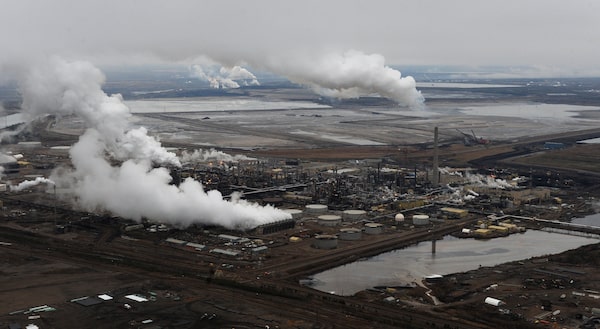
The Syncrude oil sands extraction facility with the Suncor extraction facility in the background, near Fort McMurray, Alta. on Oct. 23.MARK RALSTON/Getty Images
Grant Bishop is the Calgary-based founder of KnightFork, which builds data-driven tools for carbon pricing and the energy transition.
Last month, Alberta’s government launched a review of its carbon-pricing system, the Technology Innovation and Emissions Reduction Regulation.
TIER is by far the most important regime for reducing greenhouse gases, or GHGs, from industrial facilities in Canada. In 2020, it covered over 50 per cent of GHGs from large emitting facilities across the country – 154 megatonnes of GHGs under TIER relative to the total of 273 megatonnes. For the system to provide durable incentive for decarbonization, Alberta’s review must ensure that large emitters face much more stringent obligations than the present design requires.
Most importantly, TIER participants and project developers need better information about the market than is available today – particularly, transparency around credit prices. Without a central exchange or mandatory reporting of credit prices, new entrants struggle to understand the market. Such opacity risks deterring low-carbon investments – from new renewable-power generation to carbon capture, use and storage (CCUS).
TIER is an output-based pricing carbon system in which facilities receive free allocations of credit based on a benchmark emission intensity for a given product, such as tonnes of GHGs per tonne of bitumen, kilowatt-hour of electricity or tonne of cement. This output-based design aims to mitigate “carbon leakage” – the loss of production to countries where carbon isn’t priced – for emission intensive, trade-exposed industries.
A facility only pays the carbon price on the difference between its actual emission intensity and its benchmark. Reciprocally, a high-performing facility with emission intensity less than its benchmark earns credits on that difference. Certain activities, such as CCUS, renewable generation and methane mitigation, also earn offsets.
However, under TIER, benchmarks for most sectors (notably excepting electricity) are assigned based on a given facility’s historical emission intensity. These facility-specific benchmarks differ from output-based carbon pricing, where a common benchmark emission intensity applies to all producers of the same product. For TIER, only power generation faces a mandatory product-specific benchmark, although other facilities can opt into a high-performing benchmark for their respective product.
TIER’s complex design is an attempt to provide incentives from carbon pricing to reduce GHGs while preserving competitiveness by minimizing producers’ costs. Nonetheless, the value at stake in TIER is big: At the $30-per-tonne carbon price, emitters’ 21 megatonnes of obligations in 2020 translate to more than $600-million in costs. With Alberta’s rebound during 2021 and the $40-per-tonne carbon price, I estimate total obligations to be more than $1-billion. This should increase as Canada’s carbon price climbs to $170 per tonne by 2030.
But TIER’s complexity also makes for tricky and opaque market dynamics – particularly for the seesaw between emitters’ obligations and available credits and offsets. Notably, shifting to facility-specific benchmarks under TIER from product-specific benchmarks under Alberta’s former Carbon Competitiveness Incentive Regulation dramatically reduced stringency for the province’s carbon pricing. Under CCIR, emitters’ obligations comprised 20 per cent of large emitting facilities’ GHGs in Alberta. Under TIER, this share dropped to 14 per cent.
In a post last month, I detailed how, for a conservative scenario of GHG reduction in Alberta and even with a 1-per-cent annual tightening in TIER’s benchmarks, the number of offsets and credits would exceed large emitters’ obligations. Such an oversupply would depress prices for credits and offsets and thereby discourage investments in further decarbonization – such as, for example, Alberta’s more than 60 megatonnes of so far announced potential CCUS capacity.
Experts Blake Shaffer and Dale Beugin have usefully outlined in The Globe and Mail how governments could de-risk policy uncertainty for these projects through so-called contracts-for-difference, which effectively guarantee the value of carbon credits over the life of a given project.
Nonetheless, government guarantees should not be pure taxpayer-funded subsidies. Market-based mechanisms for pricing carbon must preserve transparent, durable and escalating incentives for emitters to reduce GHGs. Market efficiency also requires that participants have complete information – particularly about prices.
Currently, TIER participants trade offsets and credits “over the counter” rather than on a central exchange. This means that no prices are publicly reported for trades under TIER. Although the Alberta Carbon Registry provides a current snapshot of offset and credit holdings, it does not publish historical transactions. Such an opaque market privileges incumbents over upstarts.
By capturing past snapshots, KnightFork has visibility on trades and, with participation from certain TIER participants, aims to publish a voluntary survey of TIER credit prices this month. However, to enhance transparency for the carbon-pricing system, Alberta’s government should mandate reporting of credit and offset prices.
For industrial emissions in Canada, Alberta is the frontline, and our province’s progress in reducing GHGs will determine whether the country achieves our 2030 target. Making TIER more stringent and transparent will provide more durable price incentives for the necessary new investments in decarbonizing Alberta industry.
Keep your Opinions sharp and informed. Get the Opinion newsletter. Sign up today.